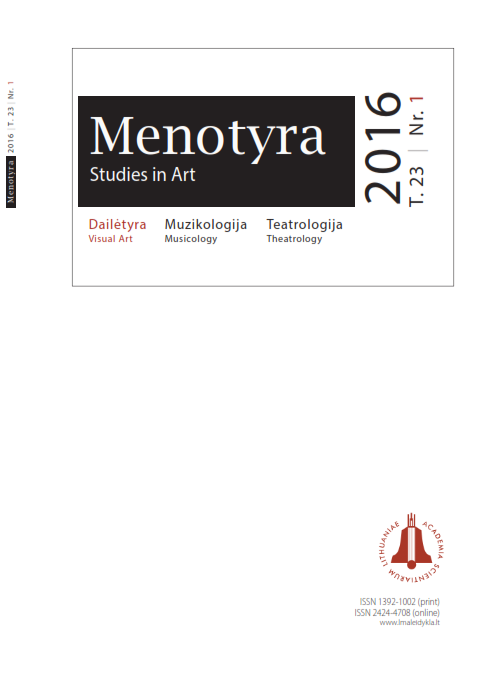Vieno biblinio ciklo kilmės ir ikonografijos paieškos
One biblical cycle: search of the origin and iconography
Author(s): Asta GiniūnienėSubject(s): Fine Arts / Performing Arts, Visual Arts
Published by: Lietuvos mokslų akademijos leidykla
Keywords: biblical cycle; scenes of the Old and New Testament; Thesaurus Sacrarum; Theatrum Biblicum; Christian iconography; Evangelical Lutheran Church;
Summary/Abstract: The article analyses a biblical cycle that previously hung in the cemetery chapel in Vilkėnai, Švėkšna Parish. The cycle consists of eight paintings depicting scenes from the Old Testament – Abraham and Three Angels, Lot, Angels and Sodomits, Brothers Sell Joseph, Joseph and the Wife of Potiphar, Samson and Lion, Revelation to Jonah the Prophet, The Prophet Jonah is Swallowed by a Great Fish, a Fish Spits the Prophet Jonah up onto Dry Land and three scenes from the New Testament – the Prodigal Son between Animals, the Return of the Prodigal Son, the Dinner at the Pharisees’ Simon House. Until the middle of the 19th century, no evidence of the biblical paintings could be found in the archival sources of the Catholic Church in Švėkšna. The character of the pictures – selection of the scenes, figuration (same frame used for the painted compositions), inscriptions in cartou ches (quotations from the Bible or short annotation of the plot) – is characteristic of the visual tradition of the Evangelical Lutheran churches of the second half of the 17th century. The lack of historical data does not allow to draw the final conclusion that the investigated cycle was painted for the Evangelical Lutheran Church, although the interpretation and artistic character are similar to the works of Lutheranian style. The prototypes and examples of many pictures from Švėkšna were engravings by Gerardo de Jodes from the book Thesaurus Sacrarum (Antwerp, 1585), which were copied in the first half of the 17th century by a Dutch graphic designer and publisher Claes Janszoon Visscher and integrated into the albums of Theatrum Biblicum (Amsterdam, 1639, 1643, etc.). Two later paintings on the history of Joseph were created according to engravings compositions by Erbauliche Erzählungen (1761). Through the prototypes of the 16th century, the cycle of paintings is associated with the European Renaissance iconographic tradition of biblical images. According to available data, it is the only currently known biblical cycle of this character and representation remaining in Lithuania, which is important in the studies of Christian art.
Journal: Menotyra
- Issue Year: 23/2016
- Issue No: 1
- Page Range: 1-21
- Page Count: 21
- Language: Lithuanian

